Notes on Learning and Memory
- The Nature of Learning
- learning - the process by which experiences change our nervous system and behavior
- memory - the changes produced by learning
- the storage metaphor - experiences are not "stored"
- by changing the structure of the nervous system, experiences change the way we perceive, think, plan, and behave
- perceptual learning - learning to recognize a stimulus
- stimulus-response learning - learning to make a particular response in the
in the presence of a particular stimulus
- classical conditioning
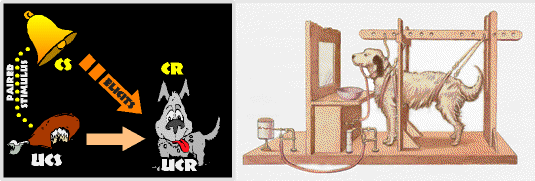
- instrumental (operant) conditioning
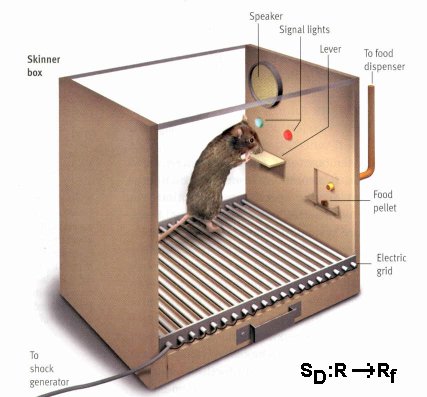
- the Hebb rule (after D. O. Hebb) - if a synapse repeatedly becomes active at about the same time the postsynaptic neuron fires, changes will take place that strengthen the synapse (i.e., make it more likely that changes in the presynaptic terminal will cause changes in the postsynaptic cell)
- classical conditioning
- motor learning - learning to make a new (motor) response
- relational learning - a complex form of learning that involves the relations among individual stimuli, and includes spatial learning, episodic learning, and observational learning
- Learning and Synaptic Plasticity ("plastic" = changeable)
- induction of long-term potentiation (LTP) - Lomo (1966)
- intense ("tetanic") stimulation of axons leading from the entorhinal cortex to the
dentate gyrus (the "perforant path") causes a long-term increase in the magnitude of
postsynaptic potentials in the dentate gyrus cells
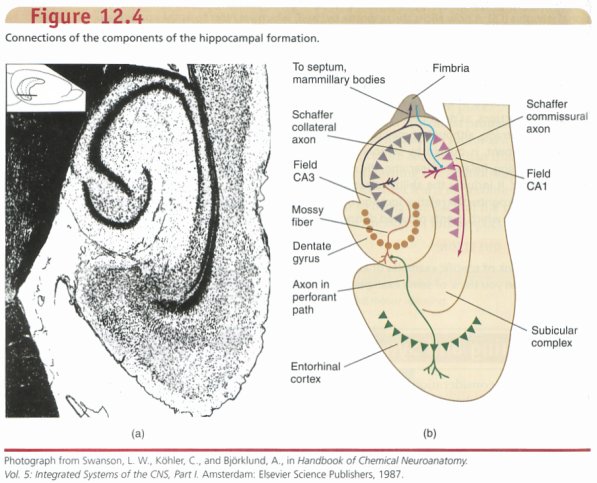
- how the effect is produced and recorded - the population EPSP
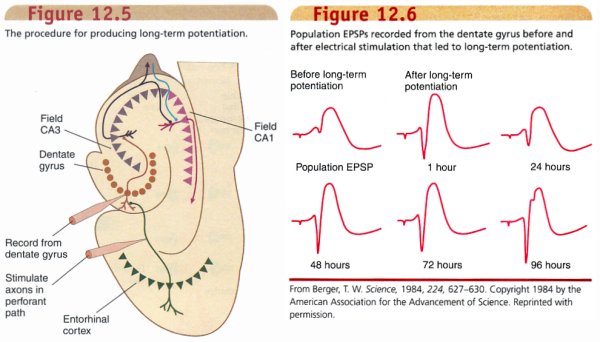
- LTP can be produced in many areas of the brain and can last for several months
- associative LTP
- occurs in Field CA1 of the hippocampus (and elsewhere)
- results from stimulating two inputs to the CA1 pyramidal cells
- appears to obey the Hebb rule - when a weak and strong input are stimulated simultaneously, the weak input is strengthened
- intense ("tetanic") stimulation of axons leading from the entorhinal cortex to the
dentate gyrus (the "perforant path") causes a long-term increase in the magnitude of
postsynaptic potentials in the dentate gyrus cells
- role of NMDA receptors
- synaptic strenghtening seems to occur when a molecules of neurotransmitter bind to a receptor on a dendritic spine that is already depolarized - thus two factors are required: release of neurotransmitter and postsynaptic depolarization
- blocking NMDA receptors with a drug such as AP5 prevents LTP in CA1 of the hippocampus
- the NMDA receptor is a glutamate receptor with some peculiar properties - it is BOTH
electrically gated and chemically gated
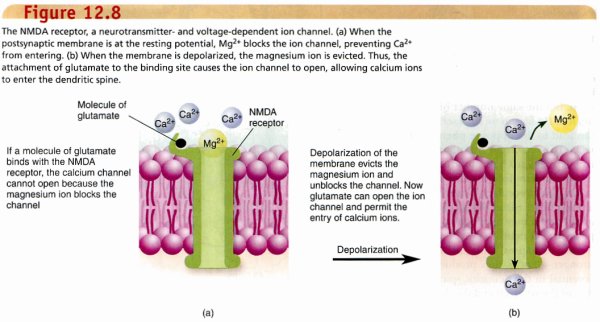
- the "calcium signal" can be blocked with EGTA, which binds to Ca++ ions and renders them biologically inert - EGTA injected into the CA1 pyramidal cells blocks the formation of LTP
- CA1 pyramidal cells have the peculiar property that they can form spikes (APs) in their dendrites, but only when an AP is formed at the initial segment of the axon - the backwash of depolarization triggers a dendritic spike
- whenever a CA1 pyramidal neuron fires, all of its dendritic spines become briefly
depolarized - if a weak synapse is active during this backwash of depolarization, it
will become strengthened
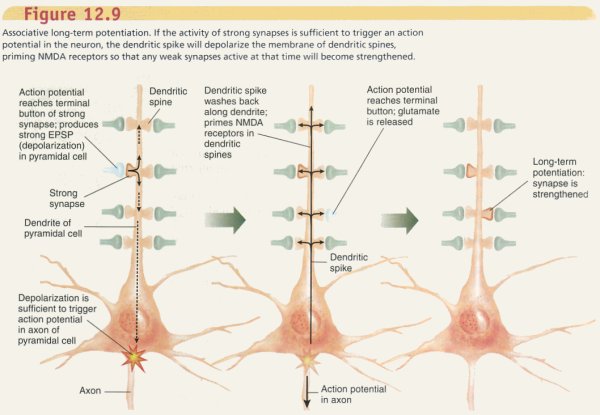
- animations 12.1 and 12.2 on the CD are very instructive here
- mechanisms of synaptic plasticity
- two mechanisms
- new synapses are produced (or old ones are "pruned")
- individual synapses are strengthened
- formation of new synapses
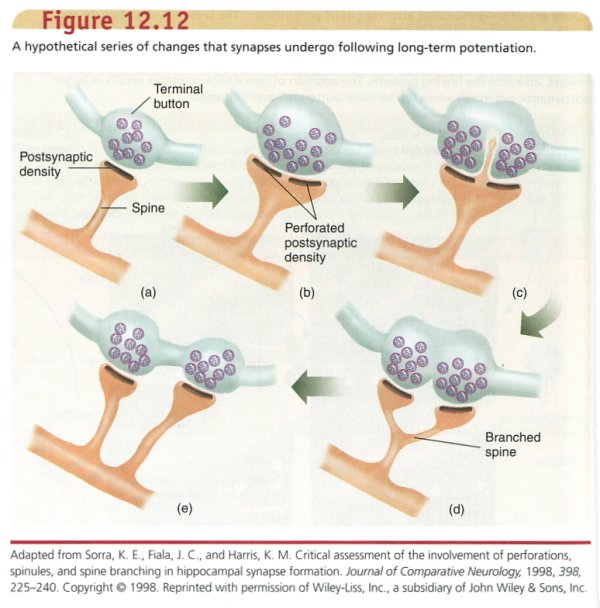
- strengthening of individual synapses
- postsynaptically this occurs due to the insertion of new AMPA receptors in the postsynaptic membrane
- these receptors are proteins, so they could be built as needed, but this would take time
- evidence suggests that the receptors have been preassembled in a storage location - when LTP is produced, they are moved into place on the postsynaptic membrane
- this requires the action of calcium-dependent enzyme called CaM-KII (in mice
with a genetic mutation that prevents the biosynthesis of normal CaM-KII, LTP
cannot be produced)
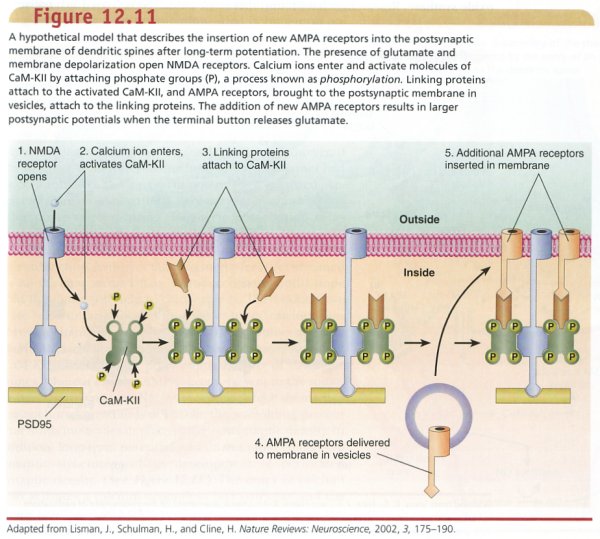
- postsynaptic AND presynaptic strengthening
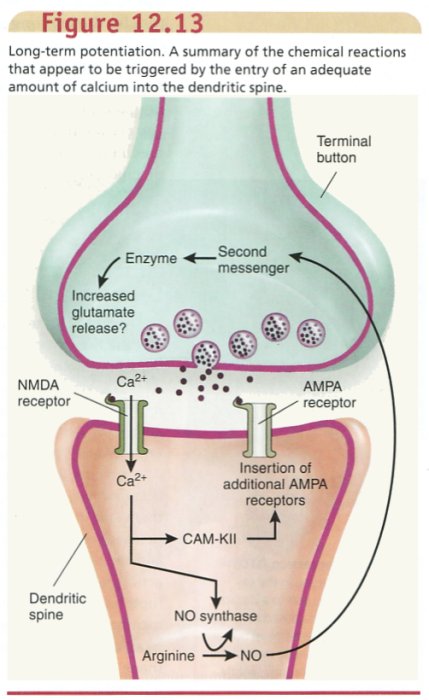
both are due to the action of the calcium signal
insertion of new AMPA receptors postsynaptically - due to the activation of the enzyme CAM-KII
activation of nitric oxide synthase postsynaptically
production of nitric oxide
nitric oxide diffuses through the cell membrane and acts as a retrograde messenger
activates enzymes in the presynaptic terminal - results in increased release of neurotransmitter
- two mechanisms
- long-term depression - the weakening of a synapse due to asynchronous release of neurotransmitter and postsynaptic depolarization
- induction of long-term potentiation (LTP) - Lomo (1966)
- Perceptual Learning
- perceptual learning is most obvious when familiar things change - when a friend you've known for years suddenly shows up with glasses, for example
- "perception" occurs in the sensory association cortex
- visual object recognition in the inferior temporal cortex
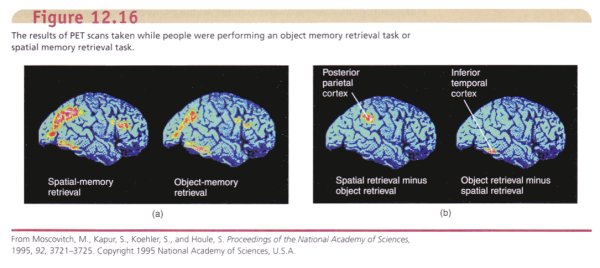
- Penfield and Perot (1963) - electrical stimulation of this area elicited vivid visual memories in human patients undergoing brain surgery
- damage here results in a loss of ability to recognize objects (although vision itself is not impaired) - visual agnosia
- visual object recognition in the inferior temporal cortex
- Classical Conditioning - LeDoux's experiments on emotional learning
- the fear conditioning paradign - the conditioned emotional response
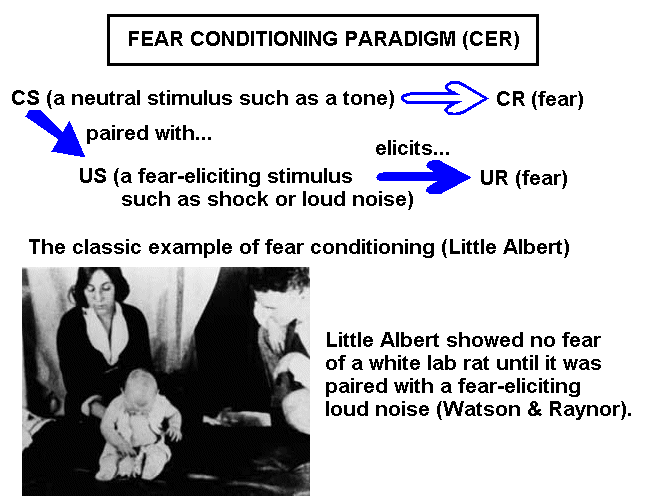
- to find the area in the brain underlying this conditioning, two conditions must be met:
- info about both the CS and US must converge there
- the area must have something to do with the production of the UR (fear)
- the amygdala and fear
- Kluever and Bucy showed in the 1930s that removal of the temporal lobes in monkeys resulted in a profound taming
- later it was shown with rats that this was due to destruction of the amygdala
- activation in the basolateral amygdala occurs within a second of a fear-eliciting
stimulus
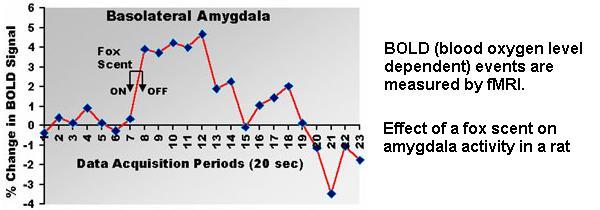
- in Urbach-Wiethe Disease (a genetic disorder), in addition to changes in the skin and
mucus membranes, there is degeneration of the amygdala: a case...
S. M. failed what Damasio calls "the Doris Day test". "When we showed her a film clip of Doris Day screaming, she asked, `What is she doing?'," he says. In fact, S. M. was baffled by any picture showing a fearful expression. She also had problems deciphering mixtures of negative emotions, such as anger and surprise. By contrast, she had no difficulty with "positive" emotions such as happiness. She was also perfectly able to recognise familiar faces (Nature, vol 376, p 669).
JENNIFER ALTMAN From New Scientist magazine, vol 144 issue 1956, 12/171994. (reference to quotation above)
- benzodiazepines, used to treat anxiety disorders in humans, apparently work in the amygdala - if their activity in the amygdala is blocked in experimental animals, their anxiolytic effect is eliminated
- how the amygdala organizes a fear response
- how you react to danger without thinking
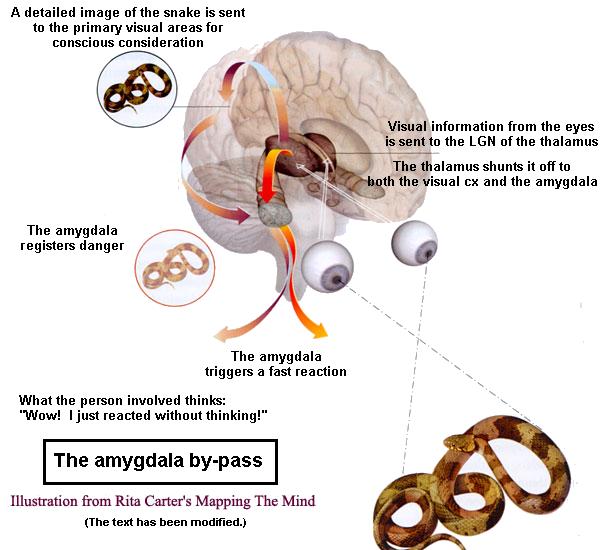
- the input to the central nucleus comes from other nuclei of the amygdala
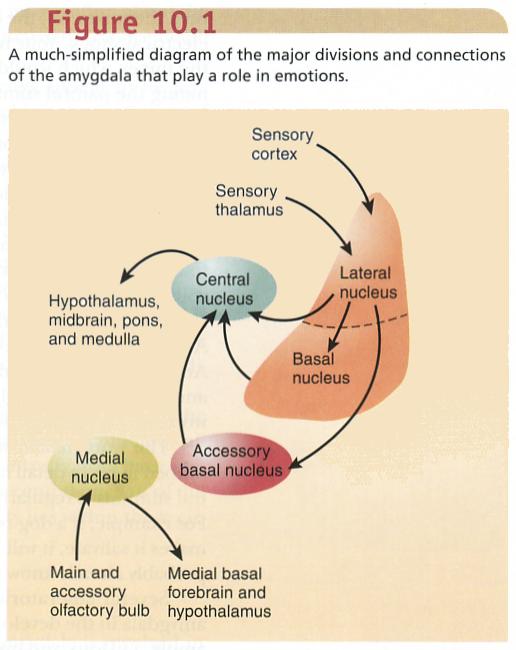
notice the inputs to the lateral nucleus from sensory cortex as well as sensory nuclei of the thalamus
so the requirements of a brain area supporting classical conditioning are met - the amygdala organizes fear responses, and it receives input about both USes and neutral stimuli from all sensory modalities (primary sensory cx as well as association cx), and also from the hippocampal formation
now to show that the lateral amygdala supports classical condition through the mechanism of LTP
- LeDoux conditioned rats by pairing a tone CS with an electric shock US
- they measured blood pressure and heart rate, as well as behavioral freezing, as URs
- within a few tries the CR developed
- if the central nuc. of the amygdala is destroyed, conditioning does not take place
- if NMDA receptors are blocked with AP5, conditioning does not occur
- firing rates of neurons in the lateral nuc. are also consistent
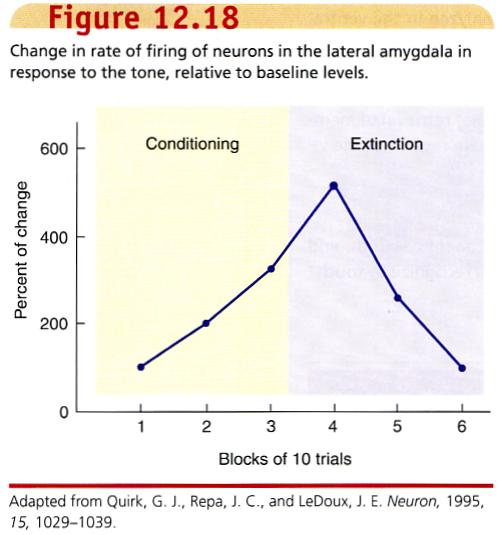
- so the evidence suggests it works this way
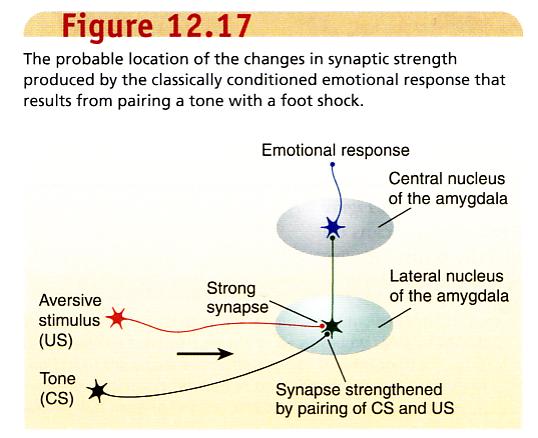
- the fear conditioning paradign - the conditioned emotional response
- Instrumental Conditioning
- instrumental conditioning is the means by which we learn to benefit from our experience
- several processes are involved
- "stamping in" behaviors that result in positive consequences (reinforcement)
- "stamping out" behaviors that result in negative consequences (punishment)
- relinguishing behaviors that have neutral consequences (extinction)
- acquisition of new behaviors when necessary (motor learning)
- strengthening (or weakening) of the connection between perception of the discriminative stimuli and the motor apparatus that produces the response
- the role of the basal ganglia in acquisition of new behaviors (motor learning)
- anatomy
- role in motor disorders - disorders of voluntary behavior
- Parkinson's disease
- athetosis and choreiform movements
- Huntington's disease
- circuits responsible for instrumental conditioning - must connect sensory association cortices where perception takes place to motor association cortex where movements are planned and executed
- there are two such pathways
- direct transcortical connections - acquisition of complex behaviors that involve deliberation or instruction
- connections via the basal ganglia and thalamus
- when we are first learning new behaviors (typing, riding a bicycle, serving a tennis ball, playing the piano, driving a car, etc.), they require deliberation and are slow and awkward - they require a great deal of the brain's resources as we must concentrate on them
- as the behaviors are learned and perfected, they become increasingly automatic and
require less conscious deliberation - this corresponds with the behaviors being taken
over by the basal ganglia
- the BG are always kept informed of what the cortex is doing, but at first the BG are just passive observers
- eventually the BG take over the behavior - at this time we no longer need to think about the behavior and we can devote the transcortical circuits to other tasks
- the automatization of behavior seems to be disrupted by blocking NMDA receptors in the BG - suggests that LTP is involved
- reinforcement
- neural circuits involved in reinforcement
- in 1954 James Olds and Peter Milner published a landmark article in which they reported that rats will bar press for electrical stimulation of certain parts of the brain (which, the story goes, they discovered by accident)
- it was quickly discovered that the highest rates of responding were supported
by electrodes implanted in the medial forebrain bundle (MFB) - among other
things, this pathways connects the ventral tegmental area (VTA) to the nucleus
accumbens
medial forebrain bundle - this is the mesolimbic dopamine system - the nucleus accumbens is a "hotbed" of
dopamine receptors
nucleus accumbens - this is at least one, and perhaps the primary, reinforcement system in the brain
- anything that activates this pathway will produce a reinforcing effect
- stimulation of VTA, or the MFB, or the administration of cocaine or
amphetamine, as well as the occurrence of natural reinforcers, cause the release
of DA in the nuc. accumbens
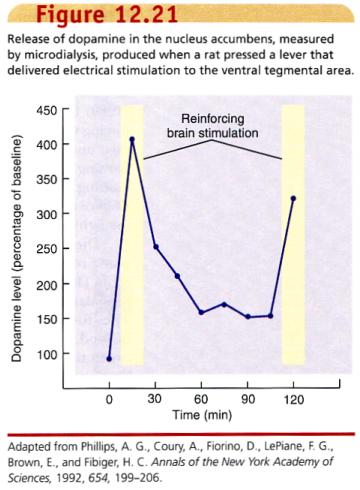
- fMRI scans show that reinforcing events activate the nuc. accumbens in humans
- this pathway also appears to play a role in addiction to most (but not all) drugs
- functions of the reinforcement system
- a reinforcement system must perform two functions:
- detect the presence of a reinforcing stimulus
- strengthen the connections between the neurons that detect the discriminative stimulus and the neurons that produce the instrumental response
- there appear to be three important inputs to the VTA that are involved in
reinforcement
- from the amygdala
- from the lateral hypothalamus
- from the prefrontal cortex
- the medial forebrain bundle diagram (again)
- a reinforcement system must perform two functions:
- neural circuits involved in reinforcement
- and at this time that's about the best we can do for instrumental conditioning
- Relational Learning
- human anterograde amnesia
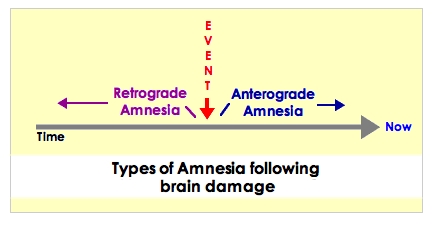
- two types of amnesia
- retrograde amnesia - forgetting the past (events before the brain damage occurred)
- anterograde amnesia - inability to form new memories for events after the brain
damage occurred
- Korsakoff's syndrome (usually due to chronic alcoholism) is characterized by severe anterograde amnesia
- anterograde amnesia can also result from damage to the temporal lobes, as in the case of H.M. - had a bilateral medial temporal lobe resection in an attempt to treat severe epileptic seizures (which was successful)
- two types of amnesia
- details of the case of H.M.
- basic description - (EXTERNAL LINK)
the case of HM
diagrams and an MRI of the surgery- description from 1968 (Milner et al. as quoted by Kolb and Whishaw)
NOTE: THESE LINKS WILL NOT COME UP ON-LINE, SO DON'T CLICK THEM! - HM pg 1
- HM pg 2
- HM pg 3
- a more recent description (2002) from the BBC
- HM BBC 2002
THIS IS THE END OF THE LINKS THAT WON'T COME UP ON-LINE. YOU MAY RESUME CLICKING.
- description from 1968 (Milner et al. as quoted by Kolb and Whishaw)
- the conclusions of Scoville and (Brenda) Milner
but first, a lesson about the structure of memory- the hippocampus is not the location of LTM, nor is it necessary for retrieval
- the hippocampus is not the location of STM
- the hippocampus is involved in converting STM into LTM - consolidation
- spared learning abilities - the amnesia does NOT involve a total loss of learning
abilities
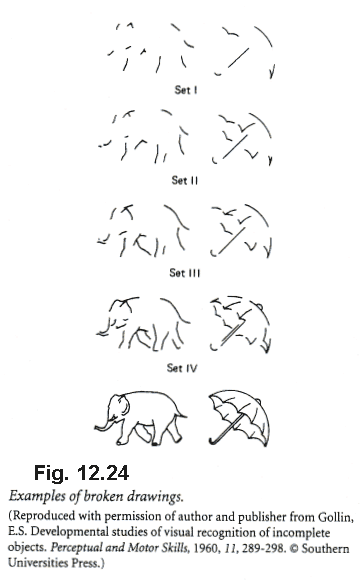
- tested with broken figure drawings - showed retention an hour later as well as four months later
- if shown pictures of faces and told a story about them - three weeks later if shown the same pictures he would not remember having seen them before but would like the picture of people he heard nice stories about more than pictures of people he heard nasty stories about
- could acquire a classically conditioned eyeblink response
- could acquire an operantly conditioned sequence of button presses
- could learn motor tasks such as pursuit rotor and mirror tracing although he never remembered having seen the apparatus before
- could learn procedural tasks like tower of hanoi problems
- priming - see below
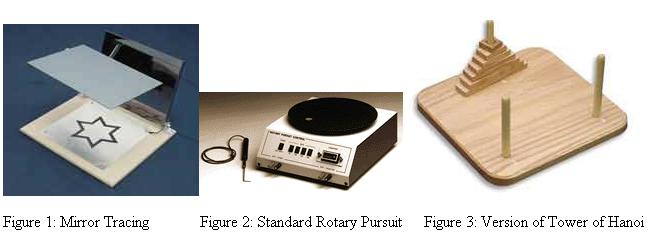
- his performance on priming tasks was perhaps the most remarkable
- the subject is shown a list of words and then some time later is given cued
recall
stimulus item recall cue basket ba________ lecture le________ etc. - when told it was a memory task and he was to recall the previously seen word, he performed poorly
- when told simply to fill in the first word that comes to mind, he performed
well, usually filling in the word he had been shown
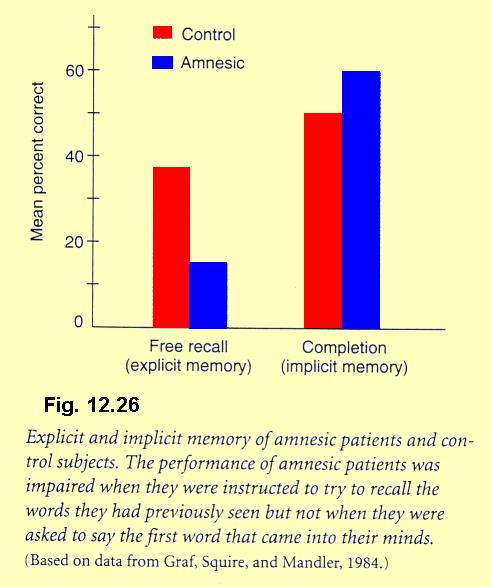
- furthermore, when (normal) subjects are told this is a memory task (given the
memory instructions), the hippocampus is activated, but this does not happen if
they are not told it is a memory task (completion instructions)
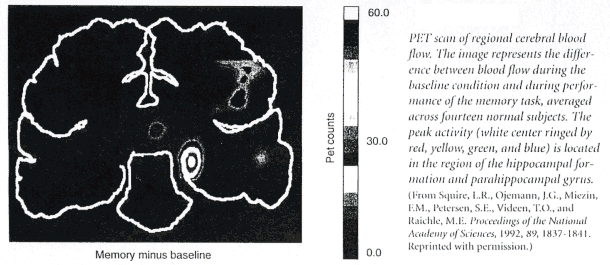
- the subject is shown a list of words and then some time later is given cued
recall
- basic description - (EXTERNAL LINK)
the case of HM
- declarative and nondeclarative (procedural) memories

- declarative memories - those explicitly available to conscious recall; memories for facts and events; memories you can talk about; the type of memories you are forming right now as you read this (hopefully!)
- nondeclarative memories - implicit memories that cannot really be "talked about" but
that can be demonstrated through performance
- anatomy of anterograde amnesia - damage to the hippocampus, or to regions that supply its
inputs and receive its outputs, causes anterograde amnesia
- wiring of the hippocampus
- field CA1 appears to be particularly important - patient R.B., who suffered a period
of anoxia due to cardiac arrest, was found 5 yrs. later at autopsy to have virtually
no cells in field CA1
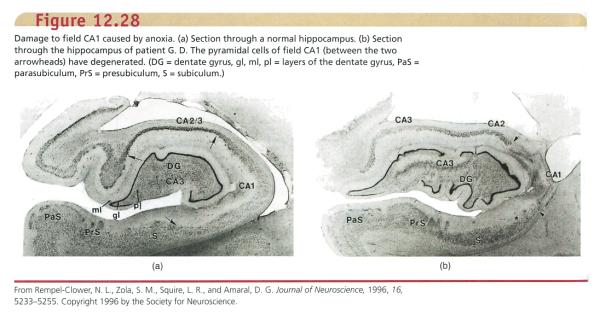
- CA1 is especially rich in NMDA receptors - which may explain its importance in memory formation as well as why it is easy to destroy by anoxia (excitotoxicity)
- anterograde amnesia is a failure of relational learning
- theory - the hippocampus links together perceptual memories into a complex memory of life events (episodes)
- enables us to learn the relationships between simple parts of events, as well as the context in which they occurred
- patients with hippocampal damage can learn "simple" things but cannot relate them to context or to other memories (which is to say, they cannot form episodic and semantic memories)
- the hippocampal formation and spatial memory
- hippocampal damage results in deficits in spatial memory in both humans and experimental animals - cannot learn to navigate around their environment
- the most profound loss is caused by bilateral damage, but right hippocampal damage also causes deficits in spatial memory
- damage to the left hippocampus causes relatively minor loss of spatial memory
- relational learning in lab animals
- spatial perception and learning
- rats with hippocampal damage have difficulty learning a Morris milk (water) maze (see video on the CD)
- hippocampal lesion in homing pigeons prevented them from learning to use familiar landmarks to navigate back to the roost
- London taxi driver studies described in the textbook
- place cells in the hippocampal formation - neurons that fire at a high rate only when experimental animals (rats, monkeys) are in a particular location or, in the case of monkeys, when they are looking at or "contemplating" a particular location
- role of LTP in relational learning - when LTP in the hippocampus is prevented, either by genetic manipulations or by NMDA receptor blocking drugs, relational learning is impaired or does not occur
- spatial perception and learning
- human anterograde amnesia
Return to PSYC 460 Main Page